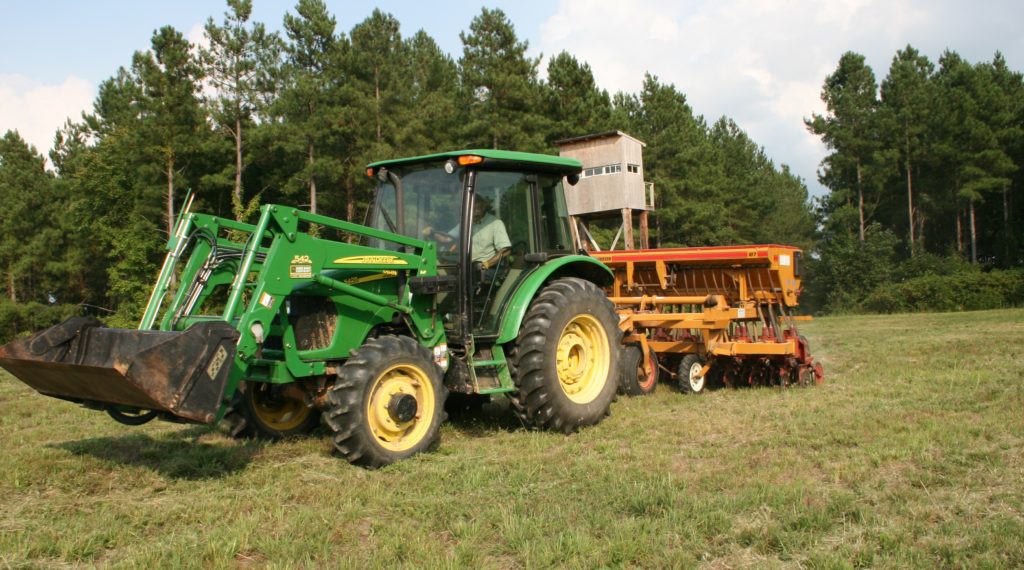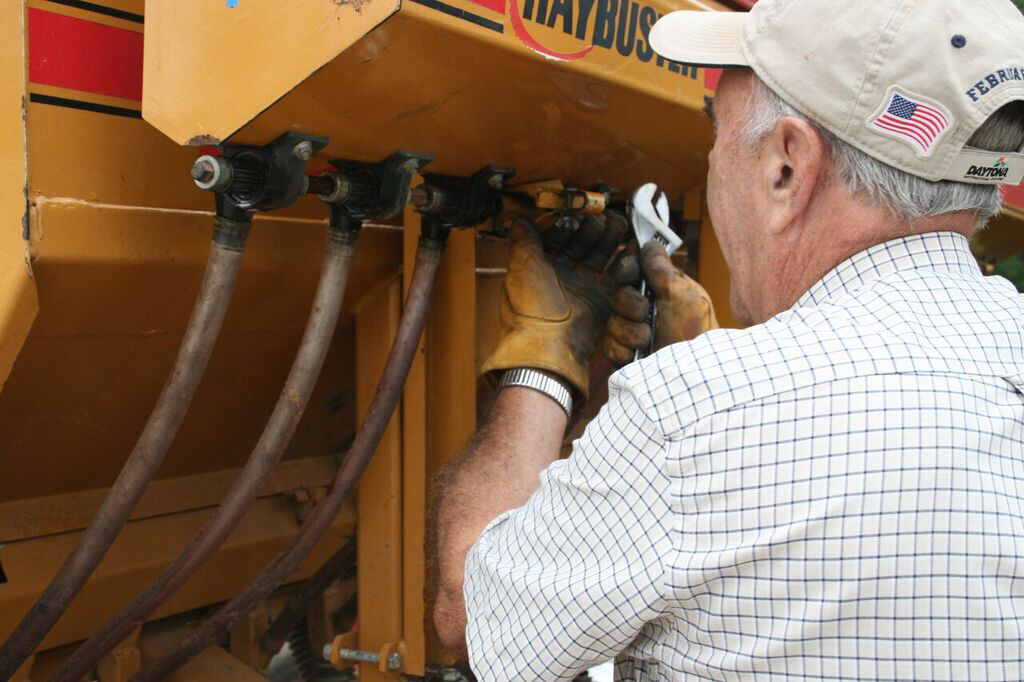
By Denny Quaiff, Executive Director, VDHA
Over the past 35 plus years, I have been directly and indirectly involved in building, planting and maintaining food plots for wildlife. I have witnessed more and more hunters and landowners filling the gap of lost habitat by building and working food plots for the wildlife on their property.
The term was coined by U.S. hunting and outdoor industries. Food plots generally consist of, but are not limited to, legumes (clovers, alfalfa, beans, oats, etc.) or forage grasses. The following is our personal list of wildlife management practices we have learned through trial and error.
 Have the Right Equipment for the Job
Have the Right Equipment for the Job
For this section we will be discussing the different types of equipment needed for starting a new plot and maintaining an established plot.
Preparing a New Site – When starting a new plot, break the ground with a heavy-duty disk. After breaking ground, spread the recommended amount of fertilizer and lime. Take the time to get a soil test before spreading your fertilizer and lime. This will save you a lot of money in the long run. We then follow the ground breaking with an 8’ rotating tiller that pulls behind the tractor and connects to the power take-off. If the plot was planted last year the rotating tiller will most likely be your best choice for reworking the site. If it’s a new site, the tiller will get the ground in the best shape you could hope for.
Now that you have cultivated the soil it’s time to sow your seed. Our club purchased a 300 pound broadcast spreader several years ago. This spreader can be pulled with the tractor or behind an ATV. It saves a lot of walking the field using a hand spreader.
Our next step is to run a cultipacker over the site. Most seed manufacturers highly recommend this process that rolls the seed into the ground. It firms the seed bed giving good seed to soil contact for better germination.
Maintaining an Established Site – The most important thing that an established food plot needs is mowing. We try to mow our plots for the first time in the spring by May 15. Follow the first mowing with a top dressing of fertilizer. If the site has clover and chicory planted, the clover will make its own nitrogen. Heavy applications of nitrogen will burn the clover. A good rule of thumb is 200 to 300 pounds of 0-20-20 to the acre that will strengthen your plot’s root system.
The biggest challenge for maintaining food plots is controlling the weeds and unwanted grasses. I cannot over emphasize how important it is to have a regular mowing schedule. We try to mow all of our sites every 30 days to six weeks, depending on the rainfall. Another thing we recommend is to spray the site with a herbicide called Poast. The best results we have achieved are from spraying this a week to 10 days after mowing. This will give the weeds time to grow above the forage plants and help the herbicide make better contact with the weeds.
Our hunt club has been renting a grain drill for our Labor Day weekend fall planting from the County Extension Agent for years.
This has been one of the best things we have ever done for food plot maintenance. The 8’ machine has three hoppers that allow us to plant clover, chicory and oats at the precise depth prescribed by the manufacturer all at the same time. We can drill 18 to 20 acres of seed in 8 to 10 hours. The no-till grain drill is the way to go!
Maintaining perennial food plots on our property has proven to be an asset. This ongoing effort has paid off and greatly enhances our Quality Deer Management Program.
 Quality Seed is a Key to Successful Plots
Quality Seed is a Key to Successful Plots
If you take your deer management seriously you need to target their year-round health. If you are trying to grow big bucks with impressive antlers, and healthy does for good fawn recruitment, a loss of nutrition could decrease the potential.
The two basic types of food plots for whitetails are warm season and cool season plots. For this article we will discuss both.
We plant our food plots on Labor Day weekend each year. Fall planting has been more successful for us than spring planting. With cooler days and nights in the fall less rain is needed. Also, the facts are that winter precipitation is far more foreseeable than in the late spring and summer months.
After years of trying different seeds for food plots, we have learned that a mix of clover, chicory and winter oats is a great choice for spring, summer, fall and winter food plots. This forage mixture will create a smorgasbord of food to the deer’s liking and keep them coming back.
Clover – Deer need food high in protein and minerals during the spring and summer, with more carbohydrates in the late fall and winter.
It goes without saying; the best clover to plant is one that will grow where you hunt with the highest protein levels. This would normally be white clover, which has protein levels that approach that of alfalfa. Alfalfa is a great deer food, but my experience with trying to establish an alfalfa plot has not been good. My advice would be to stick with the clover. It’s hard to beat.
Chicory – When working food plots, always look for user-friendly plants that are easily maintained. Chicory fits the bill and runs a close second to clover as a high protein, high mineral food source. It is very important to have plants that withdraw minerals from the soil.
Soy Beans and Chicory are both high protein plants and preferred by whitetails. However, we found that Soy Beans will die if eaten when they first start to come up, which makes it all but impossible to grow on food plot sites.
Chicory is one of the best food plot plants that we have found. Whitetails primarily browse Chicory in the spring and summer. However, I have personally shot deer in early December that were eating Chicory when I pulled the trigger.
Oats – If you’re looking for a cool season, cereal grain for food plots that will attract deer during hunting season, Oats would be a great choice. During the first months of growth, Oats are very high in protein. We have found that the deer on our property prefer Oats over other cereal grains, such as Wheat.
When planting Oats you need to make sure that seed is covered with 1 to 2 inches of soil for proper germination. For your best results, plant in well drained soils with pH between 6 and 7. The recommended amount of Oat is 100 pounds to the acre. Oats do extremely well when planted as a cover crop with clover, that makes its own nitrogen, which jump-starts the Oats for the cold winter months to follow.
 Conclusion
Conclusion
As wildlife habitat continues to shrink throughout the Old Dominion, there is more of a demand for hunters, hunt clubs and landowners to make an honest commitment to supplement the habitat. In order to maintain quality wildlife resources, high energy foods must be abundant throughout the year.
Take time and energy to become a true steward of the land. Talk with the people at your local feed and seed co-op about planting in your area. For more technical questions consult a wildlife biologist or the county extension agent in your county. If your goal is to have bigger and healthier deer, it’s time to get involved.
©Virginia Deer Hunters Association. For attribution information and reprint rights, contact Denny Quaiff, Executive Director, VDHA.



